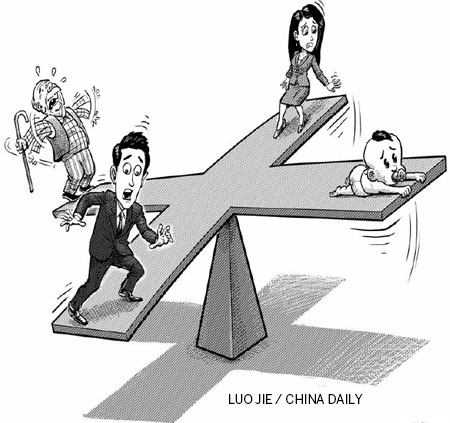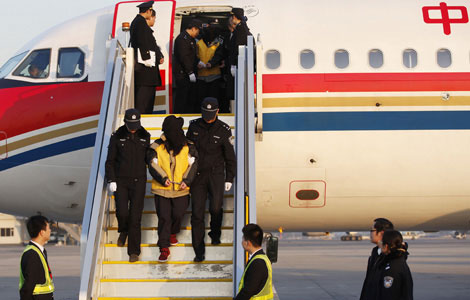Building a better population
Updated: 2013-09-26 07:59
By Noeleen Heyzer and Babatunde Osotimehin (China Daily)
|
||||||||
Half a century ago, the world was warned of the imminent explosion of "the population bomb". There were fears that humanity would suffer mass starvation and societies would plunge into turmoil - all because of overpopulation.
At that time, Asia was considered to be at the core of the population problem. The average woman in Asia could expect to bear five children. The region's population was projected to double within 33 years.
Many countries responded to the problem by embarking on programs to control population growth. The landmark 1994 International Conference on Population and Development, attended by representatives of 179 governments, shifted the discourse on "population control" to people-centred development.
The ICPD Programme of Action established, for the first time, inseparable linkages between population and development policies, with a clear focus on sexual and reproductive health from the standpoint of human rights - in particular the rights of women and families to decide freely whether and when to have children.
The probability of every child surviving to adulthood was greatly increased. Families acquired better knowledge of sexual and reproductive health. Many more were given the means to make informed decisions about their fertility.
The Asia-Pacific region can be proud of its successes: An average woman today has about two children instead of five. Life expectancy has increased dramatically. Fifty years ago, the average person could expect to live until the age of 45. Today a woman can expect to live to the age of 72 and a man to 68. Almost as many girls as boys enter primary school.
But success comes with new challenges. The concern today is not just about population. Rather, it is about the complex inter-linkages between population and development. Putting people first to build better lives must remain the focus of efforts to address the population and development challenges that the Asia-Pacific region faces.
Increased life expectancy and lower fertility rates have resulted in rapid population aging in the region that is unprecedented in human history. Some countries are at the risk of becoming old before they become rich. The population of older people will triple by 2050 to reach 1.2 billion. In East Asia, one in every three people will be aged 60 or above.
Furthermore, by 2050, there will be only 3.5 working people to support one older person, as compared with 10 working people today. There is thus an urgent need for the region to prepare for aging societies.
While the opportunity for the demographic dividend has passed in some countries, in others there is still an opportunity to harness its potential. In South Asia, about half of the population is still below the age of 25. With the appropriate mix of policies, including job-led growth and effective school-to-work transition, it will be possible to reap the youth dividend.
On issues of sexual and reproductive health and rights, great strides have been made in strengthening policy. Yet program implementation is lagging, particularly in targeting the most sexually active population group, namely youth.
Lack of information on sexual and reproductive health and limited access to related services are contributing to unintended pregnancies and unsafe abortions. These gaps are also exposing millions to the risk of HIV, in particular key populations, including people who inject drugs, prostitutes and their clients, homosexuals and transgenders. This means that comprehensive sex education and increased access to a range of contraceptives must be made a priority.
Moreover, sexual and reproductive health programs must also reach childless married women, and unmarried women and girls, as also men and boys, as part of an integrated public health system that combines curative, preventive and health promotion services.
Despite overall progress on maternal health, in some countries the number of women dying during childbirth still remains stubbornly high. There are parts of the region where one in 200 mothers dies giving birth.
Asian and Pacific countries must do better in adopting rights-based approaches to address population dynamics in their long-term plans for inclusive and sustainable development, including the impact of climate change. And most of all, the response to the region's challenges must be grounded in a commitment to addressing the unmet needs of women and all other groups that remain excluded from the development process.
How do we collectively tackle these new and persistent challenges? That question was put on the table at the Sixth Asian and Pacific Population Conference, which the Economic and Social Commission for Asia and the Pacific organized with UN Population Fund last week in Bangkok. The conference was part of, and will contribute to, the global ICPD 20-year review mandated by the UN.
As Asia-Pacific takes its place on the world stage, our governments have the means and the responsibility to build better lives for the region's 4.3 billion people. There is greater hope that the rapid population and development transformation will nurture the promise of a future that will be brighter than what had been predicted half a century ago.
Noeleen Heyzer is under-secretary-general of the UN and executive secretary of the Economic and Social Commission for Asia and the Pacific. Babatunde Osotimehin is under-secretary-general and executive director of the UN Population Fund.

(China Daily USA 09/26/2013 page12)

 Djokovic announces engagement to girlfriend
Djokovic announces engagement to girlfriend
 Taipei, LA and Singapore top travel search growth list
Taipei, LA and Singapore top travel search growth list
 Big cats are part of the family
Big cats are part of the family
 Arm exhibition at Russia Arms Expo 2013
Arm exhibition at Russia Arms Expo 2013
 Rubber duck adjusting to spot at Summer Palace
Rubber duck adjusting to spot at Summer Palace
 Suspects in financial offenses arrested in SE Asia
Suspects in financial offenses arrested in SE Asia
 China champs at the bit
China champs at the bit
 Echoes of China
Echoes of China
Most Viewed
Editor's Picks

|

|

|

|

|

|
Today's Top News
Ministry welcomes WTO poultry ruling against US
Xi reaffirms education top priority
China, Russia issue joint statement on Syria
China to improve policies for overseas investment
Airbus scores in China with $6b in deals
Concern about environment grows
Rich should fight poverty too: Ho
Li Tianyi jailed for 10 years for gang rape
US Weekly

|

|




